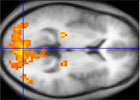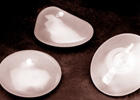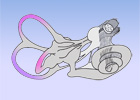 As UHN's monthly research newsletter, NRx reports on the full spectrum of leading research from UHN's five research institutes. Located in downtown Toronto, these institutes are the Princess Margaret (PM) Cancer Centre, the Toronto General Research Institute (TGRI), the Toronto Western Research Institute (TWRI), the Toronto Rehabilitation Institute (TRI) and the Techna Institute (Techna).
As UHN's monthly research newsletter, NRx reports on the full spectrum of leading research from UHN's five research institutes. Located in downtown Toronto, these institutes are the Princess Margaret (PM) Cancer Centre, the Toronto General Research Institute (TGRI), the Toronto Western Research Institute (TWRI), the Toronto Rehabilitation Institute (TRI) and the Techna Institute (Techna).
In this issue you can read about:
- A new anticancer therapy entering clinical trials
- The link between obesity and depression
- An HIV treatment linked to low birth weights
- Nanotechnology to visualize and treat cancer
- Barriers to breast reconstruction surgery
- The discovery of a new type of motion sickness
We hope that you will find NRx informative. If you have feedback or questions, please contact www@uhnresearch.ca.
Christopher J. Paige, PhD, FCAHS
Vice President, Research
University Health Network

While the study focused on breast cancer, CFI-400945 also has similar anticancer activity in other types of solid tumour cancers.
An exciting new study from Dr. Tak Mak and his team describes the discovery of an effective new potential anticancer agent. The team used an approach that combined functional RNAi analysis with gene expression analysis in breast cancer-derived cell lines and in human breast cancers replicated in mice. Using these multidimensional datasets for human breast cancer, the enzyme PLK4 was identified as a candidate target among 10,000 other targets for the development of anticancer therapeutics. Their work also showed that an aggressive form of basal breast cancer was dependent on PLK4 for survival and that depleting it induced cell death.
"This finding led to the identification of CFI-400945, a selective and orally active inhibitor of PLK4, which was shown to have significant antitumour activity as a single agent in a variety of preclinical tumour models," says Dr. Mak, a PM Senior Scientist and the Director of The Campbell Family Institute for Breast Cancer Research. In addition, this antitumour activity was observed in tumour models with a PTEN gene deficiency. PTEN, a tumour suppressor, is known to be defective in as many as half of all advanced solid tumour cancers.
"If clinical testing supports our hypothesis that PTEN is a predictive biomarker for CFI-400945, we will have another way to tailor personalized cancer medicine based on an individual's genetics," says Dr. Mak. The next phase of research for this new drug is evaluation in human cancer patients, and a Phase I clinical trial initiated early this year is currently ongoing at the Princess Margaret Cancer Centre and University of California, Los Angeles.
This study was supported by the Canadian Institutes of Health, Genome Canada and the Princess Margaret Cancer Foundation. T Mak is a Tier 1 Canada Research Chair in Inflammation Responses and Traumatic Injury.
Functional characterization of CFI-400945, a PLK4 inhibitor, as a potential anticancer agent. Mason JM, Lin DCC, Wei X, Che Y, Yao Y, Kiarash R, Cescon DW, Fletcher GC, Awrey DE, Bray MR, Pan G, Mak TW. Cancer Cell. Jul 2014. [Pubmed abstract]

Body weight may influence the body's ability to respond to antidepressant drugs.
Major depressive disorder is often associated with obesity, suggesting that they may be linked. A handful of previous studies have tried to examine whether a person's body weight or body mass index (BMI)—a measure of body weight relative to body length—is able to predict response to antidepressant therapies, but have failed to provide conclusive results. A limitation of these previous studies is that BMI data were grouped into broad categories (eg, normal, overweight or obese), thus potentially concealing subtle differences.
The research team led by Dr. Roger McIntyre, Clinical Researcher at TWRI, used a more direct approach. Rather than grouping patients into categories, they simply recorded the body weight and BMI of people with depression, and then initiated treatment with the antidepressant fluoxetine. Patients' response to treatment was assessed using two different depression questionnaires and rating scales. This approach revealed that higher body weight and BMI before treatment were associated with having a worse response to the drug.
Currently, different BMI cutoff points are used to define overweight and obese categories depending on ethnicity. This study highlights that current BMI category definitions may result in loss of information and explain the inconsistent results seen in the past.
This work was supported by the Kai-Syuan Psychiatric Hospital, the National Science Council of Taiwan and the Toronto General and Western Hospital Foundation.
Both body weight and BMI predicts improvement in symptom and functioning for patients with major depressive disorder. Lin CH, Chen CC, Wong J, McIntyre RS. Journal of Affective Disorders. 2014 June. [Pubmed abstract]

Without treatment, the risk of HIV transmission from a breastfeeding mother to her child is estimated to be between 20 and 45%.
Human immunodeficiency virus (HIV) can be transmitted from mother to child during pregnancy, labour, delivery and breastfeeding. This can be prevented by treating mothers with a combination of drugs known as combination antiretroviral therapy (cART). Recently, it has been shown that pregnant women treated with a type of cART known as protease inhibitor-based cART (PI-cART) are more likely to have premature babies with low birth weights. How or why this occurs is still unclear.
TGRI Assistant Scientist, Dr. Lena Serghides, has provided some insight into this phenomenon by revealing that a hormone important to normal births, known as progesterone, may be involved. Dr. Serghides found that the administration of PI-cART in an experimental model of pregnancy was associated with decreased progesterone levels and lower birth weights of offspring. Birth weights were improved by providing mothers with additional progesterone during their pregnancy. Moreover, researchers observed a similar trend in pregnant, HIV-infected women: those treated with PI-cART had lower progesterone levels and gave birth to babies with lower birth weights, in comparison to those treated with another cART and to mothers without HIV infection.
Dr. Serghides says "While the mechanisms that lead to progesterone reduction remain to be elucidated, our study provides vital information that could translate into more informed treatment choices for HIV-positive pregnant women and new ways to protect the health of their children."
This work was supported by funding from the Ontario HIV Treatment Network, the Canadian Institutes of Health Research, the Canadian Foundation for AIDS Research and the Toronto General and Western Hospital Foundation.
HIV protease inhibitor use during pregnancy is associated with decreased progesterone levels; a potential mechanism contributing to fetal growth restriction. Papp E, Mohammadi H, Loutfy MR, Yudin MH, Murphy KE, Walmsley SL, Shah R, Macgillivray J, Silverman M, Serghides L. The Journal of Infectious Diseases. 2014 July 16. [Pubmed abstract]

Magnetic resonance imaging (used above, to visualize labelled cells within the brain) relies on magnetic fields and radiowaves to create accurate images of the body.
Photothermal therapy is a promising treatment option in cancer. It exploits the ability of certain small "nanoparticles" to be incorporated specifically into tumours. Upon targeting laser light to the tumour location, these nanoparticles convert the light into heat energy and kill the tumour cells. Currently, gold nanoparticles are being used for photothermal therapy, but they are non-biodegradable and therefore raise questions as to their toxicity after long-term use.
An emerging alternative nanoparticle is the porphysome, which is biodegradable and equally as effective as gold in transferring light into heat energy. The research team of Dr. Gang Zheng, Techna Team Lead and PM Senior Scientist, recently created a porphysome loaded with the metal, manganese (Mn3+). They found that Mn3+-porphysomes are non-toxic, highly stable and have excellent photothermal properties. Furthermore, the addition of Mn3+ actually allows these nanoparticles to be visualized using magnetic resonance imaging. This has important implications as Mn3+-porphysomes can be used to simultaneously visualize tumours and apply treatment in real time, which leads to increased accuracy and efficiency of photothermal therapy.
The porphysome created by Dr. Zheng's team is a highly customizable particle that could be used to target a variety of difficult to treat cancers, thus representing a valuable new tool for development of new therapies.
This work was supported by the Ontario Institute for Cancer Research, the Natural Sciences and Engineering Research Council of Canada, the Canadian Institutes of Health Research, the Canada Foundation for Innovation and the Princess Margaret Cancer Foundation. G Zheng holds a Joey and Toby Tanenbraum / Brazilian Ball Chair in Prostate Cancer Research.
An MRI-sensitive, non-photobleachable porphysome photothermal agent. MacDonald TD, Liu TW, and Zheng G. Angewandte Chemie International Edition. 2014 May 19. [Pubmed abstract]

IBR with a silicone implant such as those pictured above can improve quality of life and emotional well-being following a mastectomy.
Approximately one third of women with breast cancer will undergo a surgical procedure called a mastectomy to remove one or both breasts as part of their treatment. For those at high risk of developing breast cancer, the procedure is often carried out as a preventative measure. Immediate breast reconstruction (IBR), where the surgeon rebuilds the breast in the same procedure as the mastectomy—sometimes sparing the skin and nipple—is one option to help improve quality of life for breast cancer survivors. However, it has been reported that IBR is under used.
PM Clinical Researcher Dr. Toni Zhong examined procedure information from the Canadian Institute for Health Information (CIHI) database to identify factors that influence the IBR choice and access to the procedure. The team found that patients receiving mastectomy without reconstruction were more likely to come from lower income or immigrant neighbourhoods. Furthermore, the likelihood that the reconstruction procedure was carried out was much higher at teaching hospitals or those institutions where two or more plastic surgeons were on staff, and patients undergoing IBR were more likely to travel longer distances to get the procedure. "As well as socioeconomic factors, the undersupply of plastic surgeons in Ontario may be a factor in the low rates of IBR; only 40 of Ontario's 193 hospital sites met the two or more plastic surgeon criteria," says Dr. Zhong.
This work was supported by the Canadian Breast Cancer Foundation, Cancer Care Ontario, the Institute for Clinical Evaluative Sciences, the Ontario Ministry of Health and Long-Term Care and The Princess Margaret Cancer Foundation.
Barriers to immediate breast reconstruction in the Canadian universal health care system. Zhong T, Fernandes KA, Saskin R, Sutradhar R, Platt J, Beber BA, Novak CB, McCready DR, Hofer SO, Irish JC, Baxter NN. Journal of Clinical Oncology. 2014 July. [PubMed abstract]

The vestibular system, part of the inner ear (pictured), comprises three semicircular canals (in purple) that enable motion and balance to be perceived in three dimensions.
Motion sickness can lead to distressing symptoms that include nausea, dizziness and fatigue. While the underlying cause of this condition is not known, it often occurs when sensory perceptions do not match (for example, when visual cues conflict with perceptions of balance originating from the vestibular system of the inner ear).
While motion sickness is often experienced by travellers, a related condition known as simulator sickness can occur when using gaming and virtual reality systems. Simulator sickness can occur in the absence of physical movement and is therefore said to be "visually induced"; however, very little is known about whether simulated sounds contribute to this condition.
To explore the role of sound, TRI postdoctoral fellow Behrang Keshavarz in collaboration with TRI Scientist Dr. Jennifer Campos led a study in which 20 participants were placed in an immersive virtual reality dome (iDAPT's StreetLab). Participants were exposed to a series of visual or audio cues to simulate perceptions of rotating and were also asked to tilt their heads at various points, to further enhance the simulation.
As expected, visual cues were found to be highly effective at inducing simulator sickness; surprisingly, 25% of participants also experienced the condition when exposed to sound alone. Dr. Keshavarz comments, "This finding reveals the existence of a new type of motion sickness—one caused purely by sound. This insight will help us design better simulation technologies that account for and help minimize the effects of motion sickness."
This work was supported by the Toronto Rehab Foundation.
Demonstrating the potential for dynamic auditory stimulation to contribute to motion sickness. Keshavarz B, Hettinger LJ, Kennedy RS, Campos JL. PLoS One. 2014 July 1. [Pubmed abstract]
 Dr. O'Brien is a PM Scientist, with a research focus in cancer stem cells, colorectal cancer and new anticancer therapies. The ERA will support her research into the identification of new adjuvant therapeutics to be used in combination with cetuximab—a targeted therapeutic that is used to treat colorectal cancer.
Dr. O'Brien is a PM Scientist, with a research focus in cancer stem cells, colorectal cancer and new anticancer therapies. The ERA will support her research into the identification of new adjuvant therapeutics to be used in combination with cetuximab—a targeted therapeutic that is used to treat colorectal cancer. Dr. Cypel is a TGRI Scientist with a research focus in lung transplantation, specifically the use of artificial lung devices in addition to gene and cell therapy to monitor and repair injured organs prior to transplant. The ERA will support his research into the ongoing development of a novel lung preservation approach known as normothermic Ex Vivo Lung Perfusion, which will increase the number of available lungs for life-saving transplantation procedures.
Dr. Cypel is a TGRI Scientist with a research focus in lung transplantation, specifically the use of artificial lung devices in addition to gene and cell therapy to monitor and repair injured organs prior to transplant. The ERA will support his research into the ongoing development of a novel lung preservation approach known as normothermic Ex Vivo Lung Perfusion, which will increase the number of available lungs for life-saving transplantation procedures.
 Tak Mak is a Senior Scientist at PM Cancer Centre and Director of The Campbell Family Institute for Breast Cancer Research. The most recent cancer therapeutic developed by his research team, known as CFI-400945, has been shown to be effective in preclinical models against a particularly difficult to target "triple-negative" breast cancer. The drug is currently being tested at the PM Cancer Centre and the University of California, Los Angeles in Phase I clinical trials, and joins two other drugs developed by Dr. Mak's team that are also being clinically tested.
Tak Mak is a Senior Scientist at PM Cancer Centre and Director of The Campbell Family Institute for Breast Cancer Research. The most recent cancer therapeutic developed by his research team, known as CFI-400945, has been shown to be effective in preclinical models against a particularly difficult to target "triple-negative" breast cancer. The drug is currently being tested at the PM Cancer Centre and the University of California, Los Angeles in Phase I clinical trials, and joins two other drugs developed by Dr. Mak's team that are also being clinically tested. Ralph DaCosta is a Scientist at PM Cancer Centre and Techna Faculty in Photonics. His work within cancer imaging has led to the development of a new device that could transform how chronic wounds are treated. The device, called PRODIGI, enables health care providers to rapidly track the number of bacteria in wounds at the patient's bedside thus providing physicians with an accurate diagnosis with which they can customize patient treatments.
Ralph DaCosta is a Scientist at PM Cancer Centre and Techna Faculty in Photonics. His work within cancer imaging has led to the development of a new device that could transform how chronic wounds are treated. The device, called PRODIGI, enables health care providers to rapidly track the number of bacteria in wounds at the patient's bedside thus providing physicians with an accurate diagnosis with which they can customize patient treatments.
 PM Cancer Centre Senior Scientist, Dr.
PM Cancer Centre Senior Scientist, Dr.  TGRI Senior Scientist Dr.
TGRI Senior Scientist Dr.  TWRI Senior Scientist Dr.
TWRI Senior Scientist Dr.